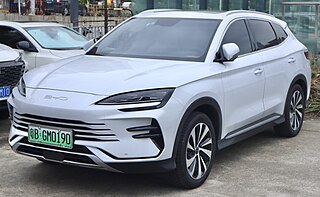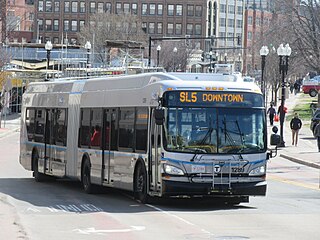
The North American International Auto Show (NAIAS), also known as the Detroit Auto Show, is an annual auto show held in Detroit, Michigan, U.S., at Huntington Place. The show was held in January from 1989 to 2019. It was intended to move to the summer in 2020, but was canceled due to the COVID-19 pandemic that year and 2021, before returning in September 2022. It is among the largest auto shows in North America. UPI says the show is "regarded as the foremost venue for [car] manufacturers to unveil new products".

A green vehicle, clean vehicle, eco-friendly vehicle or environmentally friendly vehicle is a road motor vehicle that produces less harmful impacts to the environment than comparable conventional internal combustion engine vehicles running on gasoline or diesel, or one that uses certain alternative fuels. Presently, in some countries the term is used for any vehicle complying or surpassing the more stringent European emission standards, or California's zero-emissions vehicle standards, or the low-carbon fuel standards enacted in several countries.

A plug-in hybrid electric vehicle (PHEV) or simply plug-in hybrid is a type of hybrid electric vehicle equipped with a rechargeable battery pack that can be directly replenished via a charging cable plugged into an external electric power source, in addition to charging internally by its on-board internal combustion engine-powered generator. While PHEVs are predominantly passenger cars, there are also plug-in hybrid variants of sports cars, commercial vehicles, vans, utility trucks, buses, trains, motorcycles, mopeds, military vehicles and boats.

The Honda Clarity is a nameplate used by Honda on alternative fuel vehicles. It was initially used only on hydrogen fuel-cell electric vehicles such as the 2008 Honda FCX Clarity, but in 2017 the nameplate was expanded to include the battery-electric Honda Clarity Electric and the plug-in hybrid electric Honda Clarity Plug-in Hybrid, in addition to the next generation Honda Clarity Fuel Cell. Clarity production ended in August 2021 with US leases for the fuel cell variant continuing through to 2022.

The Los Angeles Auto Show, also known as the LA Auto Show, is an auto show held annually at the Los Angeles Convention Center in Los Angeles, California, United States. It is open to the public for ten days, filling 760,000 square feet (71,000 m2) of exhibit space. Since 2006 the event is held in November or December.

The F-Cell is a hydrogen fuel cell electric vehicle developed by Daimler AG. Two different versions are known - the previous version was based on the Mercedes-Benz A-Class, and the new model is based on the Mercedes-Benz B-Class. The first generation F-Cell was introduced in 2002, and had a range of 100 mi (161 km), with a top speed of 82 mph (132 km/h). The current B-Class F-CELL has a more powerful electric motor rated at 100 kW (134 hp), and a range of about 250 mi (402 km). This improvement in range is due in part to the B-Class's greater space for holding tanks of compressed hydrogen, higher storage pressure, as well as fuel cell technology advances. Both cars have made use of a "sandwich" design concept, aimed at maximizing room for both passengers and the propulsion components. The fuel cell is a proton exchange membrane fuel cell (PEMFC), designed by the Automotive Fuel Cell Cooperation (AFCC) Corporation.

The Green Car of the Year is a Car of the Year award from the Green Car Journal. The winner is selected by an 11-member panel comprising automotive and environmental experts. Invited jurors have included Mario Andretti; Carroll Shelby, Jay Leno, Carl Pope, Christopher Flavin, Jonathan Lash and Jean-Michel Cousteau.
Hydrogen technologies are technologies that relate to the production and use of hydrogen as a part hydrogen economy. Hydrogen technologies are applicable for many uses.

A hybrid electric vehicle (HEV) is a type of hybrid vehicle that combines a conventional internal combustion engine (ICE) system with an electric propulsion system. The presence of the electric powertrain is intended to achieve either better fuel economy than a conventional vehicle or better performance. There is a variety of HEV types and the degree to which each functions as an electric vehicle (EV) also varies. The most common form of HEV is the hybrid electric car, although hybrid electric trucks, buses, boats, and aircraft also exist.

An alternative fuel vehicle is a motor vehicle that runs on alternative fuel rather than traditional petroleum fuels. The term also refers to any technology powering an engine that does not solely involve petroleum. Because of a combination of factors, such as environmental and health concerns including climate change and air pollution, high oil-prices and the potential for peak oil, development of cleaner alternative fuels and advanced power systems for vehicles has become a high priority for many governments and vehicle manufacturers around the world.

The Chevrolet Volt is a plug-in hybrid car that was manufactured by General Motors, and also marketed in rebadged variants as the Holden Volt in Australia and New Zealand and the Buick Velite 5 in China, and with a different fascia as the Vauxhall Ampera in the United Kingdom and as the Opel Ampera in the remainder of Europe. Volt production ended in February 2019.
Beijing International Automotive Exhibition, Beijing Motor Show or Auto China is an auto show held biennially in Beijing, China since 1990. China is currently the largest auto market in the world.

The history of plug-in hybrid electric vehicles (PHEVs) spans a little more than a century, but most of the significant commercial developments have taken place after 2002. The revival of interest in this automotive technology together with all-electric cars is due to advances in battery and power management technologies, and concerns about increasingly volatile oil prices and supply disruption, and also the need to reduce greenhouse gas emissions. Between 2003 and 2010 most PHEVs on the roads were conversions of production hybrid electric vehicles, and the most prominent PHEVs were aftermarket conversions of 2004 or later Toyota Prius, which have had plug-in charging and more lead–acid batteries added and their electric-only range extended.

The Cadillac ELR is a two-door, four-passenger luxury plug-in hybrid compact coupé manufactured and marketed by Cadillac for model years (MY) 2014 and 2016 – with a hiatus for MY 2015. Using a retuned version of the Chevrolet Volt's Voltec EREV drivetrain, the ELR's lithium-ion battery pack delivered an all-electric range of 37–39 miles (60–63 km) and a top speed of 106 mph (171 km/h).

The adoption of plug-in electric vehicles in the United States is supported by the American federal government, and several states and local governments.

A range extender is a fuel-based auxiliary power unit (APU) that extends the range of a battery electric vehicle by driving an electric generator that charges the vehicle's battery. This arrangement is known as a series hybrid drivetrain. The most commonly used range extenders are internal combustion engines, but fuel-cells or other engine types can be used.

The fleet of light-duty plug-in electric vehicles in Japan totaled just over 300,000 highway legal plug-in electric vehicles in circulation at the end of 2020, consisting of 156,381 all-electric passenger cars, 136,700 plug-in hybrids, and 9,904 light-commercial vehicles.

The stock of plug-in electric passenger cars in Canada in use totaled 141,060 units at the end of 2019, consisting of 78,680 all-electric cars and 62,380 plug-in hybrids. Sales totaled 50,960 units in 2019.


















